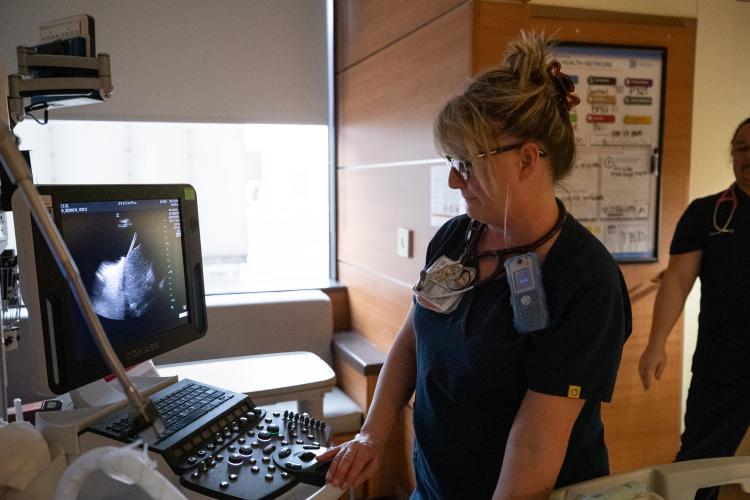
JPS Health Network respiratory therapists have incorporated ultrasound technology into their work, bringing better and more efficient care to patients faster than possible before.
“Several therapists are training with physicians right now to do lung ultrasounds, according to Jim Graves, Executive Director of Respiratory Therapy at JPS. “This is really the future of respiratory care. It’s proving to be incredibly effective in finding things early that can’t be seen other ways. It helps to identify structures like tumors and pockets of fluid in the chest cavity. There are things that might not be infectious, causing a fever, but they take up lung space, causing patients difficulty in breathing.”
When patients can’t breathe on their own, caregivers are forced to use a ventilator to artificially breathe for them. Ventilators do the job effectively, but it’s tough on patients to be on one for an extended period of time.
“Every day a patient is on ventilator increases their chance of acquiring an infection, Graves said. “Plus they can lose 7-10 percent of their muscle mass a day just lying in a bed hooked up to ventilator. It doesn’t take very long for all of the negative side effects to add up together.”
Graves said the ultrasound technology recently proved its abilities in the case of a ventilator patient who needed to be removed from the machine, but his breathing couldn’t be improved to the point that he could do it on his own for more than a short period of time. He didn’t have a fever or other signs of infection and nothing showed up on radiology imaging. His caregivers were perplexed.
“A therapist, through ultrasound technology, was able to detect a pocked of fluid in the chest that was keeping the patient’s lungs from inflating properly,” Graves said. “Because we had that information, we were able to pinpoint the problem and get rid of the fluid. By the end of the day, the patient was off the ventilator.”
JPS last summer deployed rolling ultrasound machines of the variety that expecting mothers often see when they visit their caregiver for a checkup. In the case of the mother to be, the ultrasound probe scans their belly to check on the development of the baby inside the womb. In the case of ventilator patients, it’s used to look inside the chest cavity for things that aren’t supposed to be there. Graves said JPS is in the process of adopting more portable ultrasound technology which includes a probe that pairs with a handheld tablet computer or even a smart phone.
One of my favorite things about JPS is that we’re always looking for better and faster ways to bring care to our patients. We’re a teaching hospital, so it’s important to be up on the latest technology and techniques.
“We need to try to limit how much we move very sick patients,” said Dr. Razaq Badamosi, Medical Director of Pulmonary and Critical Care at JPS, who has trained ICU respiratory therapists to use the ultrasound equipment. “With this kind of technology, we don’t have to move the patients at all to get images and, because they’re not being exposed to radiation, I can get as many images as I want.”
Badamosi said that’s important when he is trying to do a procedure to drain fluid from the chest cavity of a patient.
“If I have to put a needle in your chest, you’re going to want to make sure I get it right where it needs to be,” Badamosi said. “With ultrasound, I can see everything and be sure that I can be right in the exact spot.”
Respiratory therapist Emily Dunn said the portable technology allows her to check the lungs of her patients in about two minutes as opposed to having to roll patients in their bed to radiology for imaging. Because the ultrasound units are so efficient and portable, respiratory therapists can scan all the ventilator patients in the intensive care ward at the beginning of their shift and have a report in their files by the time the doctor arrives to check on them.
Green said ultrasound technology saves thousands of dollars a day by shortening ICU stays and opens up beds for other patients who need them.
“This is one of only a few hospitals in north Texas using this technology,” Graves said. “One of my favorite things about JPS is that we’re always looking for better and faster ways to bring care to our patients. We’re a teaching hospital, so it’s important to be up on the latest technology and techniques.”
